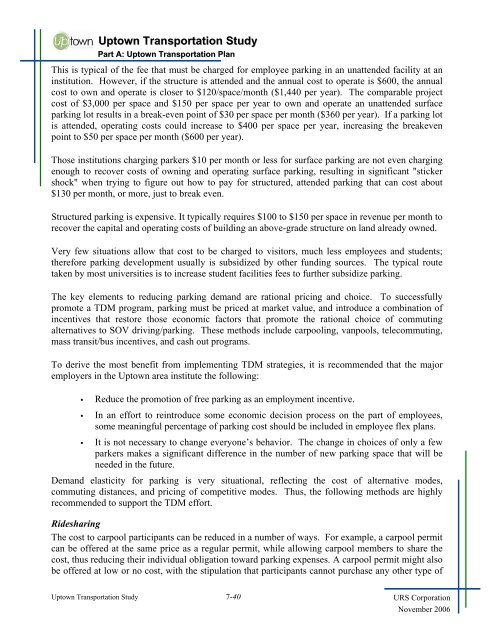Uptown Transportation Study CHAPTER 7: PARKING - OKI
Uptown Transportation Study CHAPTER 7: PARKING - OKI
Uptown Transportation Study CHAPTER 7: PARKING - OKI
Create successful ePaper yourself
Turn your PDF publications into a flip-book with our unique Google optimized e-Paper software.
<strong>Uptown</strong> <strong>Transportation</strong> <strong>Study</strong>Part A: <strong>Uptown</strong> <strong>Transportation</strong> PlanThis is typical of the fee that must be charged for employee parking in an unattended facility at aninstitution. However, if the structure is attended and the annual cost to operate is $600, the annualcost to own and operate is closer to $120/space/month ($1,440 per year). The comparable projectcost of $3,000 per space and $150 per space per year to own and operate an unattended surfaceparking lot results in a break-even point of $30 per space per month ($360 per year). If a parking lotis attended, operating costs could increase to $400 per space per year, increasing the breakevenpoint to $50 per space per month ($600 per year).Those institutions charging parkers $10 per month or less for surface parking are not even chargingenough to recover costs of owning and operating surface parking, resulting in significant "stickershock" when trying to figure out how to pay for structured, attended parking that can cost about$130 per month, or more, just to break even.Structured parking is expensive. It typically requires $100 to $150 per space in revenue per month torecover the capital and operating costs of building an above-grade structure on land already owned.Very few situations allow that cost to be charged to visitors, much less employees and students;therefore parking development usually is subsidized by other funding sources. The typical routetaken by most universities is to increase student facilities fees to further subsidize parking.The key elements to reducing parking demand are rational pricing and choice. To successfullypromote a TDM program, parking must be priced at market value, and introduce a combination ofincentives that restore those economic factors that promote the rational choice of commutingalternatives to SOV driving/parking. These methods include carpooling, vanpools, telecommuting,mass transit/bus incentives, and cash out programs.To derive the most benefit from implementing TDM strategies, it is recommended that the majoremployers in the <strong>Uptown</strong> area institute the following:• Reduce the promotion of free parking as an employment incentive.• In an effort to reintroduce some economic decision process on the part of employees,some meaningful percentage of parking cost should be included in employee flex plans.• It is not necessary to change everyone’s behavior. The change in choices of only a fewparkers makes a significant difference in the number of new parking space that will beneeded in the future.Demand elasticity for parking is very situational, reflecting the cost of alternative modes,commuting distances, and pricing of competitive modes. Thus, the following methods are highlyrecommended to support the TDM effort.RidesharingThe cost to carpool participants can be reduced in a number of ways. For example, a carpool permitcan be offered at the same price as a regular permit, while allowing carpool members to share thecost, thus reducing their individual obligation toward parking expenses. A carpool permit might alsobe offered at low or no cost, with the stipulation that participants cannot purchase any other type of<strong>Uptown</strong> <strong>Transportation</strong> <strong>Study</strong> 7-40 URS CorporationNovember 2006
















